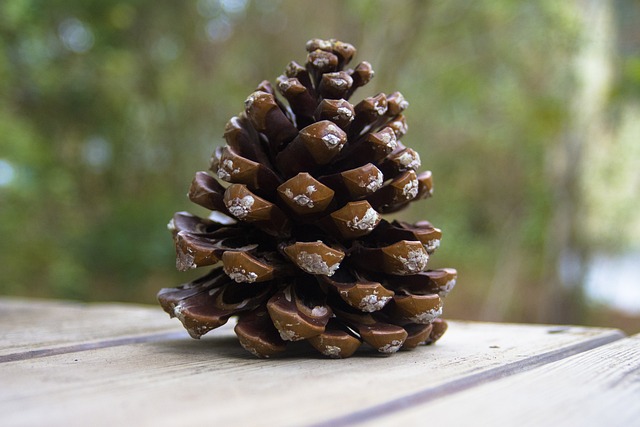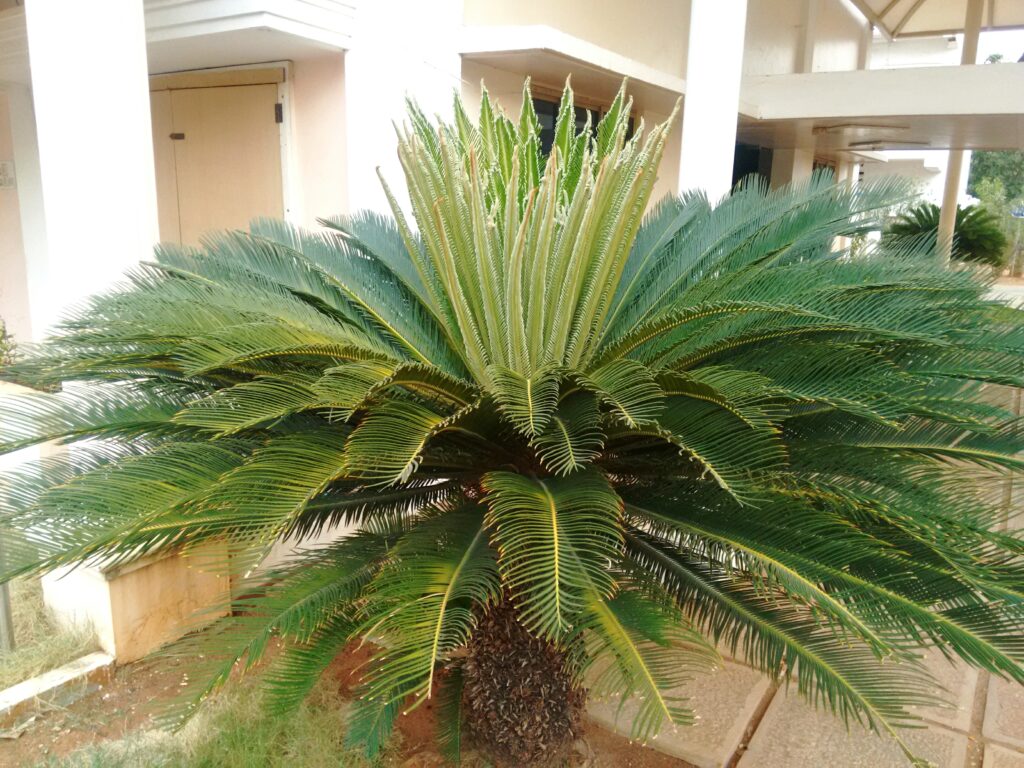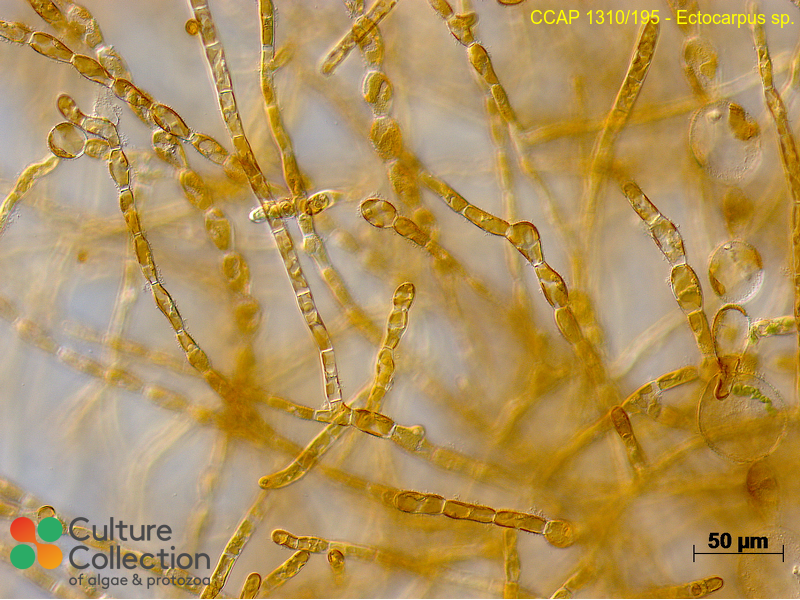INTRODUCTION
- Our understanding of the plant kingdom has changed overtime.
- Fungi and members of the Monera and Protista having cell walls have now been excluded from plantae. Cyanobacteria that are also referred to as blue green algae anyone.
- In plant kingdom, we describe algae, bryophytes, pteridophytes, gymnosperms and angiosperms.
CLASSIFICATION SYSTEMS OF PLANT KINGDOM
ARTIFICIAL
- Used only gross superficial morphological characters like habit, color, number and shapes of leaves etc.
- Based mainly on vegetative characters or on the androecium structure (system given by Linnaeus).
LIMITATION
- Separated closely related species as they were based on a few characteristics.
- It given equal weightage to vegetative and sexual characters. This is not acceptable because vegetative characters are more easily affected by environment.
NATURAL
- Based on natural affinities among organisms and consider both external and internal features, like
- Ultrastructure
- Anatomy
- Embryology
- Phytochemistry
- Such a classification for flowering plants was given by George Bentham and Joseph Dalton Hookar.
PHYLOGENETIC
- Base on evolutionary relationship between the various organisms.
- This assumes that organisms beloging to the same taxa have a common ancestor.
BRANCHES OF TAXONOMY
NUMERICAL TAXONOMY:-
- Carried out using computers. Based on observable characteristic.
- Number and codes are assigned to all characters and then data are processed.
- Each character is given equal importance and at the same time hundreds of characters can be considered.
CYTOTAXONOMY:–
- Based on cytological information like chromosome number, structure and behaviour.
CHEMOTAXONOMY:-
- Used chemical constitutes of the plants to resolve confusions.
PLANT KINGDOM- ALGAE
- In plant kingdom, Algae are chlorophyll bearing, simple, thalloid, autotrophicand largely aquatic (both fresh water and marine).
- They occur in variety of other habitats like moist stones, soil and wood.
- Some occur in association with fungi (lichen) and animals (e.g. on sloth bear).
- Form and size is highly variable, from colonial (volvox) to filamentous (Ulothrix and Spirogyra) to massive plant bodies (marine forms like kelps) to unicellular form (Chlamydomonas).
- Algae can reproduce by vegetative (fragmentation), asexual and sexual means.
- Asexual reproduction-by formationof different types of spores, Most common is zoospore.
- Sexual reproduction→
1. ISOGAMOUS=Gametes are similar in size
(i) Flagellated gametes e.g. Ulothrix
(ii) Non- flagellated gametes e.g. Spirogyra
2. ANISOGAMOUS = Gametes dissimilar in size e.g. Eudorina
OOGAMOUS = Fusion between one large non- motile female gamete and a smaller male gamete e.g. Volvox,Fucus.
ECONOMIC IMPORTANCE
- At least a half of the total CO2 fixation on the earth is carried out by algae.
- Being photosynthetic they increase the level of dissolved oxygen in their immediate environment.
- They are primary producer of energy-rich components which form the basis of food cycles of all aquatic animals.
- Many species of Porphyra, Laminaria and sargassum are among 70 species of marine algae used as food.
- HYDROCOLLOIDS lke algae (brown algae) and carrageen (red algae) are used commercially.
- Agar obtained from Gelidium and Gracilaria are used to grow microbes and in preprations of ice-creams and jellies.
- Chlorella are rich in proteins and used as food supplement even by space travelers.
THE THREE MAIN CLASSES OF ALGAE
CHLOROPHYCEAE:–
- Usually grass-green due to dominance of Chl-a & b. Commonly called green algae.
- Pigments are localised in definite chloroplasts.
- Most members have one or more storage bodies in the chloroplasts called pyrenoids, which contain protein & starch.
- Have rigid cell-wall made of inner-cellulose and outer layer of pectose.
- Sexual reproduction may be isogamous, anisogamous or oogamous.
- Eg Chlamydomons, Volvox, Ulthrix,Spirogyra, Chara.etc.
PHAEOPHYCEAE:-
- Found primarily in marine habitats.
- Commonly called brown algae.
- Possess Chl-a,c: carotenoids and xanthophylls.
- Olive green to various shades of brown depending on amount of xanthophyll pigment fucoxanthin.
- Food storage as lamination and mannitol
- Cellulosic cell wall covered by algin.
- Plant body usually has holdfast, slipe and frond.
- In most brown algae pear shaped biflagelled zoospores have two unequal laterally attached flagella.
- Sexual reproduction may be isogomous, anisogamous or oogamous.
- Gametes pyriform with two laterally attached flagella.
- Eg. Ectocarpus, Dictyota, Laminaria, Sargassum, Fucus etc.
RHODOPHYCEAE:–
- Red algae have predominance of red pigment r-phycoerythin in their body.
- Possess chl-a and d.
- Majority are marine with greater concentrations found in warmer areas.
- Occur both in well-lighted regions close to water surface or at great depth in ocean where little light penetrates.
- Cell wall is made up of cellulose, pectin and polysulphated esters.
- Mostly multicellular with some having complex body organisation.
- Food stored as floridean starch, very similar to amylopectin and glycogenin structure.
- Asexual scopes and gametes are non-motile
- Sexual reproduction is cogamous and accompanied by complex post fertilisation developments.
- Eg. Polysiphonia, Porphyra, Gracilaria, Gelidium etc.
PLANT KINGDOM-BRYOPHYTES (Mosses
and Liverworts)
- In plant kingdom, Bryophytes commonly grow in moist shaped area in the hills.
- Called Amphibians of plant kingdom, because these plants can live in soil but are dependent on water for sexual reproduction.
- Rhizoids may be unicellular or multicellular.
- Main plant Body is haploid (gametophyte).
- Multicellular sex organ (antheridium & archegonium)
- Antherozoids are biflagellated.
- Some mosses provide food for herbaceous mammals, bird and other animals
- Species of Sphagnum provide peat used as fuel and as packing material for trans-shipment of living material as they hold water.
- Mosses (along with Lichens) are of great ecological importance, they decompose rocks making substrate suitable for growth of higher plants.
- They playplay an important role in plant succession on bare rocks/soil.
- Mosses form dense mats on soil, reduce the impact of falling rain and prevent soil erosion.
BRYOPHYTES ARE DIVIDED INTO
(I) LIVERWORTS
- Plant body thalloid.
- Thallus dorsi-ventral, appressed to the substrate.
- Leafy members have tiny leaf like appendages in two rows on stem-like structures.
- Asexual reproduction is by fragmentation and gemmae.
- Gemmae are green, multicellular, asexual buds formed in gemma cups located on thalli.
- Sporophyte is differentiated into a foot, seta and capsule. After meiosis spores are produced in the capsule, which germinate to produce free-living gametophytes. EG Marchantia.
(ii) MOSSES
- Gametophytes consist of two stages
1. Protonema 2. Leafy-stage
- Protonema stage: develops directly from a spore, protonema is creeping, green, branched and frequently filamentous stage.
- Leafy-stage: develops from secondary protonema as a lateral bud, They consist of upright, slender axes bearing spirally arranged leaves, attached to the soil through multi-cellular branched rhizoids. It also bears sex-organs.
- Vegetative reproduction: by fragmentation and budding in secondary protonema.
- Sporophyte in mosses is more elaborate than in liverworts. They have more elaborate mechanism of spore dispersal.
- Eg. Funaria, Polytrichum, and Sphagnum.
PLANT KINGDOM- PTERIDOPHYTES
(Horsetalls and Ferns)
- In plant kingdom, Pteridophytes evolutionarily, they are the first terrestrial plants with vascular tissues.
- Found in cool, damp, shady places, though some flourish in sandy-soil.
- Main plant body is sporophyte (2n),with true root, stem and leaves.
- Leaves are small (microphylls) as in selaginalla or large (macrophylls) as in ferns.
- Sporophytes bear sporangia subtended by sporophyll, which may be compact called strobili or cones, as in Selaginella, Equisetum.
Sporangia(2n)-Sporemother Cell(2n)-(Meiosis)—Spores(n)
- Spores germinate to produce inconspicuous, small, multi-cellular, free-living,mostly photosynthetic thalloid gametophytes called prothallus.
- Gametophytes need cool, damp, shady places to grow. This spacific requirement and need of water for fertilisation limit the spread of living pteridophytes and restricted to narrow geographical regions.
- Male and female sex organs are antheridia and archhridia and archegonia.
- Majority are homospores, but genera like Selaginella and Salvinia are heterosporous. In heterosprous species the female gametophytes are retained on the parent sporophyte. Zygote develops into young embryos within female gametophytes. This eventis aprecursor to seed habit, considered an impirtant step in Evolution
- Used for medicinal purposes and as soil binders, also grow as ornamentals.
- Pteridophytes are further classified into four classes:
1. Psilopsida- Psilotum
2. Lycopsida– Selaginella, Lycopodium
3. Sphenopsida– Equisetum
4. Pteropsida– Dryopteris, Pteris, Adiantum
PLANT KINGDOM- GYMNOSPERMS (Gymnos=
naked, sperma=seed)
- Plant in which ovules are not enclosed by ovary wall and remain exposed both before and after fertilisation. Seed that develop post- fertilisation are naked.
- In plant kingdom, Gymnosperm include medium-sized or tall trees and shrubs.
- The giant redwood tree sequoia is one of the tallest species.
- Roots: generally tap roots, having fungal association as mycorrhiza (pinus) or coralloid root with nitrogen cyanobacteria as in cycas.
- Stem: Branched (pinus; cedrus), unbranched (cycas)
- Long and dwarf shoot: in Pinus and Ginkgo.
- Leaf: Simple (pinus); pinnate compound (cycas)
- Leaves are well- adapted to withstand extreme temperature, humidity and wind. In the conifers, needle-like leaves reduce surface area.Thick cuticle and sunken stomata help to reduce water loss.
- Gymnosperms are heterosporous
- Sporophylls ⇒Microsprophylls→ Male cone/strobili/lax
⇒Megasporophylls→Female cone/strobili
- Male and female sporangia borne on microsporophylls and megasporophylls respectively.
- Sporangia ⇒Microsporangia (2n) → Pollen grain (n)
⇒Megasporangia/Ovule (2n) — 4 Megaspores
↓
- Pinus is monoecious, i;e., male female cone or strobili are borne on same tree.( Female cone is absent is cycas).
- Male gametophte, i.e., pollen grains are highly reduced and conifined to limited number of cells.
- Female gametophytes bear two or more archegonia or female sex organs. The multicellular female gametophytes is retained within megasporangium.
- Male and female gametophytes do not have an independent free living existence.
- Pollen grains are carried by air currents and come in contact with opening of ovules.
- Fertilisation is by pollen-tube formation which carries male gametes. Zygote forms embryo and ovules from- naked seeds.
PLANT KINGDOM- ANGIOSPERMS
- In plant kingdom, angiosperms or the flowering plants, pollen grains and ovules develop in specialized structures called flowers.
→ Seeds are enclosed in fruits.
- Angiosperms are an exceptionally large group of plants occurring in wide range of habitats.
- Smallest angiosperm is wolffia.
- They are divided into two classes: Dicots having seeds with two cotyledons, reticulate venation in leaf and tetra or pentamerous flowers and monocots having single cotyledons, seed, parallel venation in leaves and trimerous flowers
- Pollination is by wind or various other agencies.
- Double-fertillisation is unique to the angiosperm. Sygnamy produces zygote and and triple-fusion produces triploid primary endosperm nucleus(PEN)
- Zygote develops in embryo (with one or two cotyledon) and PEN develops into endosperm (3n) which provides nourishment to the developing embryo. The ovules develop into seeds and the ovaries develops into seeds and the ovaries develops into fruits.
PLANT KINGDOM LIFE-CYCLES AND ALTERNATION OF GENERATIONS
- In plant kingdom both haploid and diploid cells can divide by mitosis, which leads to the formation of haploid and diploid plant bodies.
- The haploid plant body produces gametes by mitosis, so called gametophytes.
- After fertillisation zygote also divides by mitosis to produce diploid saprophyte plant body.
- Haploid spores are produced by the saprophyte by meiosis which divide to form haploid body again, thus there is alternation of generation between haploid gametophytes and spore producing sporophyte during sexual reproduction in plants.
THE DIFFERENT LIFE-CYCLE PATTERNS
- HAPLONTIC 2. DIPLONTIC 3.HAPLO-DIPLONTIC
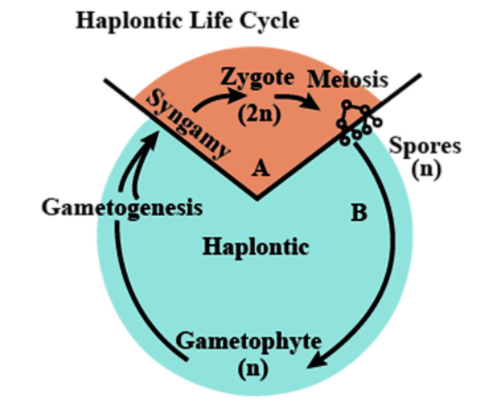
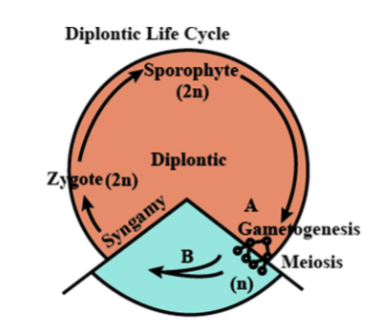
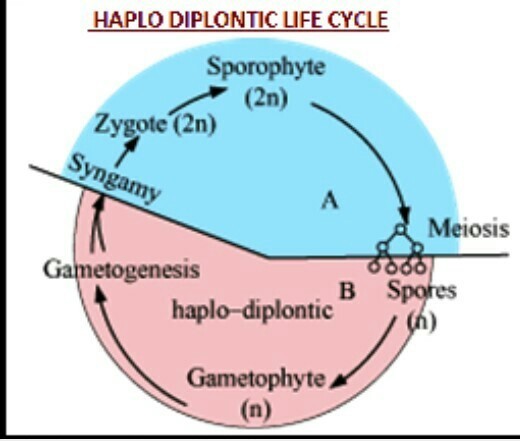
- HAPLONTIC: Sporophytic generation reprented only by single- cell zygote. There are no free living sporophytes. Meiosis in zygote produces haploid spores, which divide mitotically to form dominant, photosynthetic free-living gametophyte.
E.g., Many algae such as volvox, spirogyra and some species of chlamydomonas.
2. DIPLONTIC: Sporophytes dominant, free-living and photosynthetic. The gametophytic phase represented by single to few- celled gametophyte.
E.g., All seed bearing plants, i.e., gymnosperm and angiosperms and algae life fucus sp.
3. HAPLO-DIPLONTIC:
(a) Gametophyte dominant, independent, photosynthetic which alternates with totally or partially dependent sporophytes e.g., All bryophytes.
(b) Sporophytes dominant, independent, photosynthetic, vascular which alternates with saprophytic/autotrophic independent but short-lived gametophyte.
e.g., All pteridophytes
Some alga like Ectocarpus, Polysiphonia, kelps are also haplodiplontic.
Fun facts– 1. The plant kingdom: a tapestry of life, from towering giants to tiny blooms.
2. In plant kingdom, diversity blooms, showcasing nature’s creativity.
3. Within the plant kingdom, each species holds a vitalrole, contributing to the balance of life.
4.In the plant kingdom, green reigns supreme
5.Amongst the plant kingdom’s myriad species, diversity thrives.
6.Within the plant kingdom, life blossoms in myriad forms.
The plant kingdom, also known as Plantae, is one of the major kingdoms of living organisms. It includes a diverse group of multicellular, photosynthetic organisms that possess cell walls made of cellulose
.Plants are characterized by several features, including their ability to photosynthesize, presence of chlorophyll, multicellularity, cell walls composed of cellulose, and alternation of generations life cycle
The plant kingdom is divided into several groups, including bryophytes (mosses, liverworts, and hornworts), ferns and fern allies (pteridophytes), gymnosperms (conifers, cycads, ginkgo), and angiosperms (flowering plants).
Bryophytes are non-vascular plants that lack true roots, stems, and leaves. They include mosses, liverworts, and hornworts and are typically found in moist environments. Bryophytes reproduce via spores and have a dominant gametophyte stage in their life cycle.
Gymnosperms are seed-producing plants with naked seeds, meaning the seeds are not enclosed within a fruit. They typically have cones and include conifers (such as pine trees), cycads, ginkgo, and gnetophytes.
Angiosperms are flowering plants that produce seeds enclosed within a fruit. They are the most diverse group of plants and include herbs, shrubs, trees, and vines. Angiosperms exhibit a wide range of reproductive adaptations and have a dominant sporophyte stage in their life cycle.
Plants reproduce through both sexual and asexual methods. Sexual reproduction involves the fusion of male and female gametes, whereas asexual reproduction involves the production of offspring from a single parent plant, often through processes such as fragmentation, budding, or vegetative propagation.
Plants play vital roles in ecosystems by producing oxygen, providing food and habitat for animals, regulating the climate, and stabilizing soils. Additionally, plants are essential for human survival, providing food, medicine, shelter, fuel, and raw materials for various industries.
Plants are classified based on various characteristics, including their reproductive structures, vascular tissue (presence or absence), seed formation, and evolutionary relationships. Taxonomic ranks used for plant classification include division (phylum for some groups), class, order, family, genus, and species
Economically important plants include cereal crops (such as wheat, rice, and maize), fruits (such as apples, bananas, and oranges), vegetables, medicinal plants (such as Aloe vera and Artemisia), timber trees, ornamental plants, and cash crops (such as cotton, coffee, and tea).
